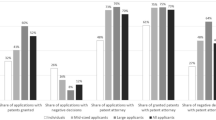Abstract
One way to achieve international patent protection is to file patents via the Patent Cooperation Treaty (PCT). The application process therein can be divided into two phases, those represented by chapters I and II of the PCT. According to the literature, patent applications filed via chapter II of the Treaty tend to be more valuable. The results presented in this paper suggest that in general this assumption is not justified. The analyses further revealed that for practitioners seeking fast patent protection at the European Patent Office (EPO) via the PCT, the choice should be chapter II of the PCT, with the EPO as preliminary examination authority.
Similar content being viewed by others
References
Albert, M. B., Avery, D., Narin, F., Mcallister, P. (1991), Direct validation of citation counts as indicators of industrially important patents, Research Policy, 20: 251–259.
Allison, J. R., Lemley, M. A., Moore, K. A., Trunkey, R. D. (2003), Valuable patents. George Mason Law & Economics Research Paper No. 03-31. http://ssrn.com/abstract=426020, (30 Jan 2005).
Brandi-Dohrn, M., Gruber, S., Muir, I. (1998), Europäisches und internationales Patentrecht: Einführung zum Europäischen Patentübereinkommen und Patent Cooperation Treaty, Praxis des Gewerblichen Rechtsschutzes und Urheberrechts. Beck, München.
Carpenter, M. P., Narin, F., Woolf, P. (1981), Citation rates to technologically important patents, World Patent Information, 3: 160–163.
Cremers, K. (2004), Determinants of patent litigation in Germany. Discussion paper / ZEW Zentrum für Europäische Wirtschaftsforschung GmbH, ftp://ftp.zew.de/pub/zew-docs/dp/dp0472.pdf, (28 Jan 2006).
DTI/OST Technology Group & IPC Subclass Mapping. Http://Www.Ipaustralia.Gov.Au/Pdfs/Statistics/Technology%20Groups.Doc, (June 27, 2006).
Ernst, H. (1996), Patentinformationen für die strategische Planung von Forschung und Entwicklung, Betriebswirtschaftslehre für Technologie und Innovation. DUV, Wiesbaden.
Ernst, H. (1998), Patent portfolios for strategic RD planning, Journal of Engineering and Technology Management, 15: 279–308.
Ernst, H. (1999), Evaluation of dynamic technological developments by means of patent data. In: K. Brockhoff & al. (Eds), The dynamics of innovation: strategic and managerial implications, Springer, pp. 105–132.
Grupp, H., Schmoch, U. (1999), Patent statistics in the age of globalisation: new legal procedures, new analytical methods, new economic interpretation, Research Policy, 28: 377–396.
Guellec, D., Van Pottelsberghe De La Potterie, B. (2000), Applications, grants and the value of patent, Economics Letters, 69: 109–114.
Guellec, D., Van Pottelsberghe De La Potterie, B. (2002), The value of patents and patenting strategies: countries and technology areas patterns, Economics of Innovation and New Technology, 11: 133–148.
Harhoff, D., Narin, F., Scherer, F. M., Vopel, K. (1999), Citation frequency and the value of patented inventions, Review of Economics and Statistics, 81: 511–515.
Harhoff, D., Reitzig, M. (2004), Determinants of opposition against EPO patent grants — the case of biotechnology and pharmaceuticals, International Journal of Industrial Organization, 22: 443–480.
Harhoff, D., Scherer, F. M., Vopel, K. (2003), Citations, family size, opposition and the value of patent rights, Research Policy, 32: 1343–1364.
Lanjouw, J. O., Schankerman, M. (2001), Symposium on the patent system and innovation — Characteristics of patent litigation: A window on competition, Rand Journal of Economics, 32: 129–151.
Nunn, H., Oppenheim, C. (1980), A patent-journal citation network on prostaglandin, World Patent Information, 2: 57–60.
Reitzig, M. (2002), Die Bewertung von Patentrechten: eine theoretische und empirische Analyse aus Unternehmenssicht, Gabler Edition Wissenschaft. DUV, Wiesbaden.
Reitzig, M. (2004a), Improving patent valuations for management purposes: validating new indicators by analyzing application rationales, Research Policy, 33: 939–957.
Reitzig, M. (2004b), Technical Quality, Market Potential, and the Value of Inventions. What Do Patent Indicators Really Measure? Copenhagen Business School Working Paper.
Schmoch, U. (1999), Patent indicators — Impact of international patent applications on patent indicators, Research Evaluation, 8: 119–131.
Author information
Authors and Affiliations
Corresponding author
Rights and permissions
About this article
Cite this article
Sternitzke, C. The international preliminary examination of patent applications filed under the Patent Cooperation Treaty — a proxy for patent value?. Scientometrics 78, 189–202 (2009). https://doi.org/10.1007/s11192-007-1837-x
Received:
Published:
Issue Date:
DOI: https://doi.org/10.1007/s11192-007-1837-x




